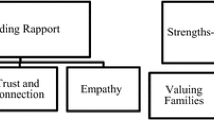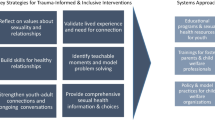Abstract
Treatment programs are needed to address the complex needs of adolescent sex trafficking survivors, yet challenges exist to engaging adolescents in treatment. The purpose of this study was to explore the perspectives of adolescent clients and clinicians regarding perceived barriers and facilitators of treatment engagement. Interviews were conducted with seven clinical staff members (including six with Master of Social Work degrees) and six clients who experienced sex trafficking and received treatment during adolescence. Consensual Qualitative Research methods were utilized to analyze interview data. Results indicated that similarities and differences exist between the perspectives of clients and clinicians regarding the barriers and facilitators of treatment.
Similar content being viewed by others
Data Availability
The datasets generated and/or analyzed during the current study are not publicly available due to protection of participants, but are available from the corresponding author on reasonable request.
References
Barrett, M. J., & Fish, L. S. (2014). Treating complex trauma: A relational blueprint for collaboration and change. Routledge.
Bass, J., Bearup, L., Bolton, P., Murray, K., & Skavenski, S. (2011). Implementing trauma-focused cognitive behavioral therapy (TF-CBT) among formerly trafficked-sexually exploited and sexually abused girls in Cambodia: A feasibility study. WorldVision.
Bent-Goodley, T. B. (2019). The necessity of trauma-informed practice in contemporary social work. Social Work, 64(1), 5–8.
Bounds, D. T., Otwell, C. H., Melendez, A., Karnik, N. S., & Julion, W. A. (2020). Adapting a family intervention to reduce risk factors for sexual exploitation. Child and Adolescent Psychiatry and Mental Health, 14(8).
Burt, I. (2019). Modern-day slavery in the US: Trafficking and counselor awareness. International Journal for the Advancement of Counseling, 41(2), 187–200. https://doi.org/10.1007/s10447-018-9366-7.
Cecchet, S. J., & Thoburn, J. (2014). The psychological experience of child and adolescent sex trafficking in the United States: Trauma and resilience in survivors. Psychological Trauma: Theory Research Practice and Policy, 6(5), 482.
Clawson, H. J., & Dutch, N. (2008). Addressing the needs of victims of human trafficking: Challenges, barriers, and promising practices. Department of Health and Human Services, Office of the Assistant Secretary for Planning and Evaluation.
Dell, N. A., Maynard, B. R., Born, K. R., Wagner, E., Atkins, B., & House, W. (2019). Helping survivors of human trafficking: A systematic review of exit and postexit interventions. Trauma Violence & Abuse, 20(2), 183–196.
Edmond, T. (2018). Evidence-based trauma treatments for survivors of sex trafficking and commercial sexual exploitation. Social work practice with survivors of sex trafficking and commercial sexual exploitation (pp. 70–96). Columbia University.
Gerassi, L. B., & Esbensen, K. (2021). Motivational interviewing with individuals at risk of sex trafficking. Journal of Social Work, 21(4), 676–695.
Herman, J. L. (2015). Trauma and recovery: The aftermath of violence–from domestic abuse to political terror. Basic Books.
Hershberger, A. R., Sanders, J., Chick, C., Jessup, M., Hanlin, H., & Cyders, M. A. (2018). Predicting running away in girls who are victims of commercial sexual exploitation. Child Abuse & Neglect, 79, 269–278.
Hickle, K. E., & Roe-Sepowitz, D. E. (2014). Putting the pieces back together: A group intervention for sexually exploited adolescent girls. Social Work with Groups, 37(2), 99–113.
Hill, C. E. (2012). Consensual qualitative research: A practical resource for investigating social science phenomena. American Psychological Association.
Hill, C. E., Knox, S., Thompson, B. J., Williams, E. N., Hess, S. A., & Ladany, N. (2005). Consensual qualitative research: An update. Journal of Counseling Psychology, 52(2), 196.
Hogan, K. A., & Roe-Sepowitz, D. (2020). LGBTQ + homeless young adults and sextrafficking vulnerability. Journal of Human Trafficking, 9(1), 63–78. https://doi.org/10.1080/23322705.2020.1841985.
Hopper, E. K., Azar, N., Bhattacharyya, S., Malebranche, D. A., & Brennan, K. E. (2018). STARS experiential group intervention: A complex trauma treatment approach for survivors of human trafficking. Journal of Evidence-Informed Social Work, 15(2), 215–241. https://doi.org/10.1080/23761407.2018.1455616.
Kim, B. K. E., Dierkhising, C. B., De Leon, J., Sandoval, J., Brissett, A., & Bounds, D. (2023). Evaluation of services for the commercial sexual exploitation of children and youth: A scoping review. Trauma Violence & Abuse, 24(5), 3236–3250.
Knott, L. E., Salami, T., Gordon, M. R., Torres, M. I., Coverdale, J. H., & Nguyen, P. T. (2021). Motivational interviewing as a therapeutic strategy for trafficked persons. Journal of Cognitive Psychotherapy, 35(2), 104–115.
Lavoie, J., Dickerson, K. L., Redlich, A. D., & Quas, J. A. (2019). Overcoming disclosure reluctance in youth victims of sex trafficking: New directions for research, policy, and practice. Psychology, Public Policy, and Law, 25(4), 225.
Litam, S. D. A., & Neal, S. (2022). Trauma-informed interventions for counselling sex trafficking survivors. International Journal for the Advancement of Counselling, 44(2), 243–262.
Marburger, K., & Pickover, S. (2020). A comprehensive perspective on treating victims of human trafficking. The Professional Counselor, 10(1), 13–24. https://doi.org/10.1524/km.10.1.13.
Miller, W. R., & Rollnick, S. (2012). Motivational interviewing: Helping people change. Guilford Press.
Munsey, S., Miller, H. E., & Rugg, T. (2018). GenerateHope: A comprehensive treatment model for sex-trafficked women. Journal of Evidence-Informed Social Work, 15(4), 420–431. https://doi.org/10.1080/23761407.2018.1467809.
National Association of Social Workers. (2003). NASW standards for the practice of social work with adolescence. Washington, DC: Author. https://www.socialworkers.org/Practice/Practice-Standards-Guidelines.
National Association of Social Workers. (2017). Code of ethics. Washington, DC: Author. https://www.socialworkers.org/About/Ethics/Code-of-Ethics/Code-of-Ethics-English.
O’Callaghan, P., McMullen, J., Shannon, C., Rafferty, H., & Black, A. (2013). Newresearch: A randomized controlled trial of trauma-focused cognitive behavioral therapy for sexually exploited war affected Congolese girls. Journal of the American Academy of Child & Adolescent Psychiatry, 52, 359–369. https://doi.org/10.1016/j.jaac.2013.01.013.
Office for Victims of Crime (2020). Human trafficking Retrieved from https://ovc.ncjrs.gov/humantrafficking/.
Ortega, J., Gordon, M., Gordon-Achebe, K., & Robitz, R. (2022). Survivors of human trafficking. Diversity in Action Springer, Cham. https://doi.org/10.1007/978-3-030-85401-0_3.
Pascual-Leone, A., Kim, J., & Morrison, O. P. (2017). Working with victims of human trafficking. Journal of Contemporary Psychotherapy: on the Cutting Edge of Modern Developments in Psychotherapy, 47(1), 51–59. https://doi.org/10.1007/s10879-016-9338-3.
Powell, C., Asbill, M., Louis, E., & Stoklosa, H. (2018). Identifying gaps in human trafficking mental health service provision. Journal of Human Trafficking, 4(3), 256–269. https://doi.org/10.1080/23322705.2017.1362936.
Reap, V. J. (2019). Sex trafficking: A concept analysis for health care providers. Advanced Emergency Nursing Journal, 41(2), 183–188. https://www.ncbi.nlm.nih.gov/pubmed/31033666.
Reid, J. A., Baglivio, M. T., Piquero, A. R., Greenwald, M. A., & Epps, N. (2018). No youth left behind to human trafficking: Exploring profiles of risk. American Journal of Orthopsychiatry, 89(6), 704–715. https://doi.org/10.1037/ort0000362.
Sawyer, S. M., Azzopardi, P. S., Wickremarathne, D., & Patton, G. C. (2018). The age of adolescence. The Lancet Child & Adolescent Health, 2(3), 223–228.
van der Kolk, B. (2014). The body keeps the score: Mind, brain and body in the transformation of trauma. UK.
Volgin, R. N., Shakespeare-Finch, J., & Shochet, I. M. (2019). Posttraumatic distress, hope, and growth in survivors of commercial sexual exploitation in Nepal. Traumatology, 25(3), 181–188. https://doi.org/10.1037/trm0000174.
Walsh, S. F. (2020). The EMDR integrative group treatment protocol for ongoing traumatic stress with female survivors of child marriage, trafficking, and exploitation in Dhaka, Bangladesh. PhD Dissertation, Liberty University Digital Commons Library, https://digitalcommons.liberty.edu/cgi/viewcontent.cgi?article=3577&context=doctoral
Wright, E. R., LaBoy, A., Tsukerman, K., Forge, N., Ruel, E., Shelby, R., & Wallace, C. (2021). The prevalence and correlates of labor and sex trafficking in a community sample of youth experiencing homelessness in Metro-Atlanta. Social Sciences, 10(2), 32.
Acknowledgements
The authors would like to acknowledge Ascent 121 and the Office for Victims of Crime for their support of this research.
Funding
The research leading to these results received funding from the Office for Victims of Crime, Award # 2019-VT-BX-0074.
Author information
Authors and Affiliations
Contributions
Author order was determined by extent of contributions to the research. The first three authors (R. Feldwisch, C. Jansing, and I. Betancourt) designed the research study, wrote segments of the literature review, submitted the IRB proposal(s), collected and analyzed data, wrote results, and prepared substantial sections of the final manuscript. The next three authors (A. Waghray, K. Horne, and C. Sanders) updated segments of the literature review, collected and analyzed data, wrote results, and reviewed manuscripts. The last author (M. Jessup) was involved with the initial design of the research study, piloted the questionnaires, assisted with recruitment, and reviewed manuscripts.
Corresponding author
Ethics declarations
Ethical Approval
The research study was approved by the Human Research Protection Program (HRPP) at the authors’ institution prior to collection of any human subjects data.
Consent to Participate
Informed consent was obtained prior to the collection of any human subjects data.
Consent to Publish
The informed consent document included consent to publish de-identified human subjects data.
Conflicts of Interest
The authors do not have any other conflicts of interest associated with this research.
Additional information
Publisher’s Note
Springer Nature remains neutral with regard to jurisdictional claims in published maps and institutional affiliations.
Rights and permissions
Springer Nature or its licensor (e.g. a society or other partner) holds exclusive rights to this article under a publishing agreement with the author(s) or other rightsholder(s); author self-archiving of the accepted manuscript version of this article is solely governed by the terms of such publishing agreement and applicable law.
About this article
Cite this article
Feldwisch, R.P., Jansing, C., Betancourt, I. et al. Barriers and Facilitators of Treatment Engagement: Perspectives Shared by Survivors of Adolescent Sex Trafficking and Experienced Clinicians. Clin Soc Work J (2024). https://doi.org/10.1007/s10615-024-00929-y
Accepted:
Published:
DOI: https://doi.org/10.1007/s10615-024-00929-y




